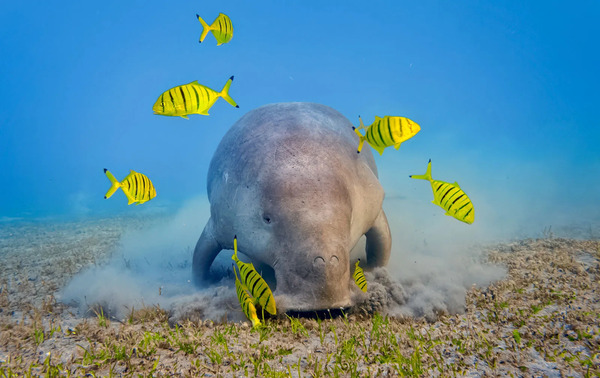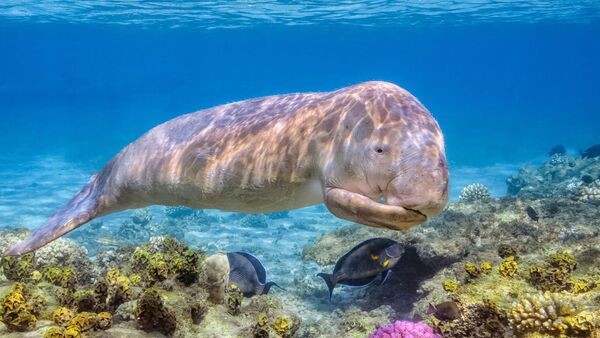Dugongs, often called "sea cows", are fascinating marine mammals that have long captured the imaginations of humans. One of the most intriguing aspects of dugongs is why they are sometimes referred to as "mermaids". This connection can be traced back to ancient myths and their physical characteristics, which have led sailors and explorers to mistakenly identify them as mythical mermaids. In this article, we will explore why dugongs are called mermaids, the history behind this association, and what makes dugongs so unique in the animal kingdom.

The dugong (Dugong dugon) is a large, herbivorous marine mammal found in warm coastal waters from East Africa to Australia. Dugongs are closely related to Manatees-Are-Endangered.html">manatees, and both species belong to the order Sirenia. Unlike other marine creatures, dugongs spend most of their time feeding on seagrasses and are typically seen slowly drifting through shallow waters.
Physical Appearance of Dugongs: Dugongs have a streamlined body that is well-suited for their aquatic lifestyle. Their tail is shaped like a fluke, resembling that of a whale, which differentiates them from Manatees-Are-Endangered.html">manatees that have round tails. Their skin is thick and leathery, often a grayish color. One of the most notable features of dugongs is their large, gentle eyes and smooth face, which some believe gives them a human-like or feminine appearance.
The connection between dugongs and mermaids dates back to the 15th and 16th centuries, when European sailors began their voyages across the seas. As they sailed through the tropical waters of the Caribbean and the Indian Ocean, many of them reported sightings of mermaids—mythical creatures with the upper body of a woman and the tail of a fish.
The First Encounters: When sailors encountered dugongs or Manatees-Are-Endangered.html">manatees, their unfamiliar appearance—especially their large, rounded body and prominent tails—could easily have been mistaken for the upper body of a human and the lower body of a fish, which are characteristics of mermaids in folklore.
The Influence of Sirens: Many of the ancient sailors’ stories of mermaids were influenced by the Greek mythological creatures known as sirens. Sirens were often depicted as beautiful women who lured sailors to their deaths with enchanting songs. The rounded shape of dugongs and their gentle, slow movements likely reminded sailors of the siren myths, contributing to the idea that these marine mammals were the real-life counterparts of mermaids.

While dugongs are not mermaids, they share some remarkable physical similarities with the way mermaids have been depicted in myths and folklore. Here are some of the key reasons why dugongs might have been linked to mermaids:
Body Shape: Dugongs have a streamlined, torpedo-shaped body that helps them glide through the water. This body shape could be mistaken for the upper body of a woman and a fish tail, which fits the description of a mermaid.
Facial Features: Dugongs possess large, dark eyes and a smooth, round face. These features might have contributed to the perception of a gentle, human-like appearance, which is often associated with mermaids in popular culture.
Behavior: Dugongs are peaceful, slow-moving creatures. Their gentle nature and behavior in the water—such as floating gracefully and feeding on seagrass—could be seen as similar to the serene, tranquil image of a mermaid in mythology.
When sailors first encountered dugongs, they were often far from home and isolated for long periods, making it easy for their imaginations to run wild. Sailors also had a tendency to exaggerate their experiences or interpret unfamiliar creatures through the lens of mythology. As a result, when they saw dugongs from a distance or in poor lighting, they could easily have imagined these sea mammals as mermaids.
Confusion and Myth Creation: The long voyages through tropical waters often meant that sailors would spend months without seeing land, leading to fatigue and a tendency to misinterpret the creatures they saw. Stories of mermaids were often passed down through oral traditions, and sightings of dugongs helped solidify the mermaid legend.
Famous "Mermaid" Sightings: One of the most famous sightings occurred when Christopher Columbus reported seeing mermaids off the coast of Haiti. Although he later acknowledged that the creatures he saw were manatees, the misconception persisted for centuries, further linking dugongs and manatees with mermaids.
Today, dugongs are considered vulnerable by the International Union for Conservation of Nature (IUCN), and their populations have been declining due to habitat destruction, hunting, and accidental capture in fishing nets. Efforts to protect these gentle sea creatures have gained attention, and there are various conservation programs dedicated to ensuring that dugongs are protected in their natural environments.
Habitat Protection: Protecting seagrass meadows, which are the primary food source for dugongs, is essential for their survival. Efforts to reduce coastal development and limit pollution can help preserve their habitats.
Reducing Human Impact: Measures to prevent accidental captures and ensure safe fishing practices are critical for protecting dugongs from human activities.
| Characteristic | Dugongs | Mermaids (Mythical Creatures) |
|---|---|---|
| Body Shape | Torpedo-shaped body, streamlined for swimming | Upper body of a human, lower body of a fish |
| Facial Features | Large, dark eyes, smooth face | Typically depicted with long flowing hair and human features |
| Habitat | Coastal waters, feeding on seagrasses | Mythically depicted as living in the sea, often near rocks or coastal cliffs |
| Behavior | Slow-moving, peaceful, herbivorous | Enchanting and often portrayed as luring sailors to danger |
| Size | Can grow up to 3 meters long, weighing around 400 kg | Varies, often depicted as being of human size or smaller |
| Conservation Status | Vulnerable, endangered in some regions | Mythical and not subject to conservation concerns |
The table above highlights the key differences between dugongs and mermaids, providing a clearer distinction between the real-world creature and the mythical beings of folklore.
The association between dugongs and mermaids has captivated the imagination of sailors and explorers for centuries. While dugongs are not mermaids, their gentle nature, unique appearance, and peaceful behavior likely contributed to the myth. Today, dugongs remain a symbol of the sea's mysterious and magical qualities, and their conservation is crucial to preserving these "mermaids of the sea" for future generations.
animal tags: Dugongidae
We created this article in conjunction with AI technology, then made sure it was fact-checked and edited by a Animals Top editor.